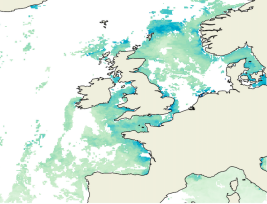Lead Supervisor: Alison M. Fowler, National Centre for Earth Observation (NCEO) and Department of Meteorology, University of Reading
Email: a.m.fowler@reading.ac.uk
Co-supervisors: Jozef Skákala, NCEO and Plymouth Marine Laboratory; David Ford, Met Office; Amos S. Lawless, Department of Mathematics and Department of Meteorology, University of Reading and NCEO.
The monitoring and forecasting of marine ecology are essential to understanding the current and future health of our coastal oceans. Long-range forecasts allow for the assessment of the impact of climate change on ocean biomass and pH trends, while shorter time-scale forecasts can help predict sudden dangerous events, such as harmful algal blooms, or oxygen depletion.
The forecasts are generated using sophisticated numerical models of marine biogeochemistry. To enable the numerical models to stay in line with the true underlying system a technique known as data assimilation (DA) is used to systematically blend the model with observations made from a myriad of instruments. One rich source of observations comes from satellite-derived sea surface chlorophyll concentrations (see figure), a proxy of how much life there is in the ocean.

Figure: Example of satellite-derived sea surface chlorophyll for 7th July 2018 on the north-west European shelf. The more intense the blue, the higher the concentration measured. Missing values are due to the presence of clouds.
DA algorithms are based on mathematical principles that make approximations about the uncertainty in both the model and observations. One of the most fundamental approximations is that both are unbiased estimates of the true underlying system (i.e. they neither systematically over- nor under-estimate). Unfortunately, this can be far from true for marine ecology models due to the complex biogeochemical processes they need to represent [Fowler et al 2022]. As such, model biases are a significant limitation of the skill of marine ecology forecasts.
Different approaches to treating bias within DA exist, but in order to apply these techniques an estimate of the bias or its statistics is needed. This is particularly challenging given that the biases are likely to have high variability in space and time.
In order to tackle this challenge of marine ecology forecasting, you will collaborate with marine ecology and data assimilation experts from the Plymouth Marine Laboratory, the Met Office, and the National Centre for Earth Observation. You will utilise the latest advancements in machine learning (ML) in order to predict the model bias. Even with the most sophisticated ML techniques, it is anticipated that there will still be limitations on how good the estimate of the model bias is due to the uncertainties and incomplete coverage of the available observations that can be used to train the ML algorithms. For example, the satellite-derived sea surface chlorophyll concentration data can itself have large biases and few observations are available of the sub-surface or of key variables other than chlorophyll. The second aim of this project is therefore to develop DA techniques that can address model biases while being resilient to the inherent limitations of the estimated model biases. Once developed, these techniques will be applied to a real-world marine ecology forecasting system.
Increasing the skill of marine ecology forecasts will have significant importance for environmental monitoring, risk mitigations and fisheries and aquaculture industries on time scales of a few days to potentially climate scales. The estimates of the model bias will also be invaluable for making improvements to marine biogeochemistry modelling. Lastly, the developed bias correction methods will also have much wider significance for many other geophysical applications ranging from numerical weather prediction to tracing
pollution sources.
Training opportunities
This studentship is a joint project with the Met Office and Plymouth Marine Laboratory (PML). The student will have the opportunity to spend time working at the Met Office and PML over the lifetime of the project. The student will also have the opportunity to attend ECMWF training courses on data assimilation and advanced training courses at Reading organised by the Data Assimilation Research Centre and the National Centre for Earth Observation
Student profile
This project is at the interface of mathematics, biogeochemistry, physics and data science. The student should have a good honours degree in a subject with strong mathematical content and programming experience. They should have a passion for environmental sciences and a creative approach to problem solving.
References
Fowler, Skakala and Ford (2023) Validating and improving the uncertainty assumptions for the assimilation of
ocean-colour-derived chlorophyll a into a marine biogeochemistry model of the Northwest European Shelf Seas.
QJRMS, 149(750), 300–324.

